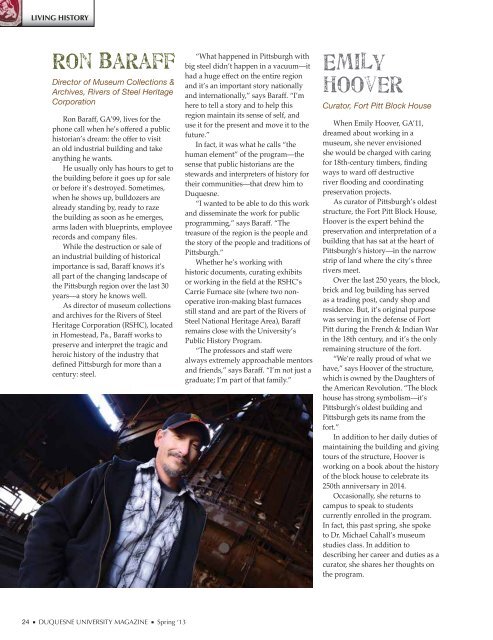2013-Spring-DU-Magazine
2013-Spring-DU-Magazine
2013-Spring-DU-Magazine
Create successful ePaper yourself
Turn your PDF publications into a flip-book with our unique Google optimized e-Paper software.
LIVING hISToRY<br />
Ron Baraff<br />
Director of Museum Collections &<br />
Archives, Rivers of Steel Heritage<br />
Corporation<br />
Ron Baraff, GA’99, lives for the<br />
phone call when he’s offered a public<br />
historian’s dream: the offer to visit<br />
an old industrial building and take<br />
anything he wants.<br />
He usually only has hours to get to<br />
the building before it goes up for sale<br />
or before it’s destroyed. Sometimes,<br />
when he shows up, bulldozers are<br />
already standing by, ready to raze<br />
the building as soon as he emerges,<br />
arms laden with blueprints, employee<br />
records and company files.<br />
While the destruction or sale of<br />
an industrial building of historical<br />
importance is sad, Baraff knows it’s<br />
all part of the changing landscape of<br />
the Pittsburgh region over the last 30<br />
years—a story he knows well.<br />
As director of museum collections<br />
and archives for the Rivers of Steel<br />
Heritage Corporation (RSHC), located<br />
in Homestead, Pa., Baraff works to<br />
preserve and interpret the tragic and<br />
heroic history of the industry that<br />
defined Pittsburgh for more than a<br />
century: steel.<br />
24 <strong>DU</strong>QUESNE UNIVERSITY MAGAZINE <strong>Spring</strong> ‘13<br />
“What happened in Pittsburgh with<br />
big steel didn’t happen in a vacuum—it<br />
had a huge effect on the entire region<br />
and it’s an important story nationally<br />
and internationally,” says Baraff. “I’m<br />
here to tell a story and to help this<br />
region maintain its sense of self, and<br />
use it for the present and move it to the<br />
future.”<br />
In fact, it was what he calls “the<br />
human element” of the program—the<br />
sense that public historians are the<br />
stewards and interpreters of history for<br />
their communities—that drew him to<br />
Duquesne.<br />
“I wanted to be able to do this work<br />
and disseminate the work for public<br />
programming,” says Baraff. “The<br />
treasure of the region is the people and<br />
the story of the people and traditions of<br />
Pittsburgh.”<br />
Whether he’s working with<br />
historic documents, curating exhibits<br />
or working in the field at the RSHC’s<br />
Carrie Furnace site (where two nonoperative<br />
iron-making blast furnaces<br />
still stand and are part of the Rivers of<br />
Steel National Heritage Area), Baraff<br />
remains close with the University’s<br />
Public History Program.<br />
“The professors and staff were<br />
always extremely approachable mentors<br />
and friends,” says Baraff. “I’m not just a<br />
graduate; I’m part of that family.”<br />
Emily<br />
Hoover<br />
Curator, Fort Pitt Block House<br />
When Emily Hoover, GA’11,<br />
dreamed about working in a<br />
museum, she never envisioned<br />
she would be charged with caring<br />
for 18th-century timbers, finding<br />
ways to ward off destructive<br />
river flooding and coordinating<br />
preservation projects.<br />
As curator of Pittsburgh’s oldest<br />
structure, the Fort Pitt Block House,<br />
Hoover is the expert behind the<br />
preservation and interpretation of a<br />
building that has sat at the heart of<br />
Pittsburgh’s history—in the narrow<br />
strip of land where the city’s three<br />
rivers meet.<br />
Over the last 250 years, the block,<br />
brick and log building has served<br />
as a trading post, candy shop and<br />
residence. But, it’s original purpose<br />
was serving in the defense of Fort<br />
Pitt during the French & Indian War<br />
in the 18th century, and it’s the only<br />
remaining structure of the fort.<br />
“We’re really proud of what we<br />
have,” says Hoover of the structure,<br />
which is owned by the Daughters of<br />
the American Revolution. “The block<br />
house has strong symbolism—it’s<br />
Pittsburgh’s oldest building and<br />
Pittsburgh gets its name from the<br />
fort.”<br />
In addition to her daily duties of<br />
maintaining the building and giving<br />
tours of the structure, Hoover is<br />
working on a book about the history<br />
of the block house to celebrate its<br />
250th anniversary in 2014.<br />
Occasionally, she returns to<br />
campus to speak to students<br />
currently enrolled in the program.<br />
In fact, this past spring, she spoke<br />
to Dr. Michael Cahall’s museum<br />
studies class. In addition to<br />
describing her career and duties as a<br />
curator, she shares her thoughts on<br />
the program.


